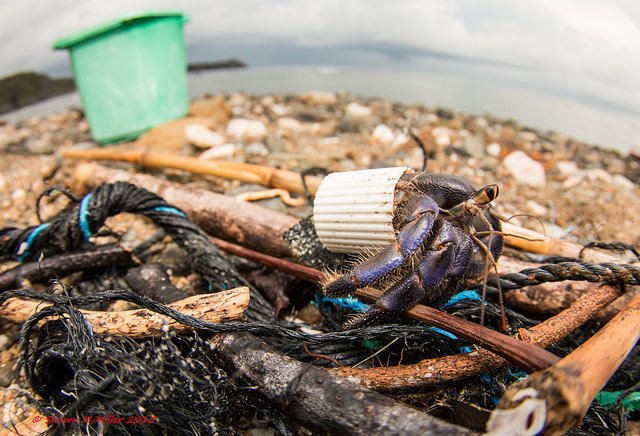Blueberry hermit crabs in Okinawa, Japan, are resourceful little creatures. Like many beaches around the world, the shores where they live and breed have become progressively covered in plastic.
Hermit crabs, unlike other crabs, don’t make their own shells. They look for abandoned shells in their surrounding habitats, often going through multiple shells in a lifetime as they grow.
The shells have to be big enough for a crab to retreat into, snug enough to not fall off, and handy enough so a crab can easily lug it around.
It turns out that bottle caps fulfill these requirements, and hermit crabs are now frequently choosing them for their homes.
Read More: Where Does the Plastic in Your Trash Go?
If you stroll along the shores of Okinawa, you can see crabs wearing caps from detergent and soda bottles.




It looks like a surreal art exhibit, a sardonic attempt to show how entwined our lives have become with plastic, or even how animals will take up the mantle of consumption in a post-human world.
Photographer Shawn Miller set out to photograph this strange phenomenon of environmental adaptation to give people a new way to think about the problem of plastic waste.
“Over the years,” Miller told Atlas Obscura, “I continued to find more crabs with trash homes. I noticed more trash piling up on our shorelines searching for hermit crabs and realized it was a serious problem.”
Globally, there are an estimated five trillion pieces of plastic in the world’s oceans.
Plastic poses numerous threats to marine life. It is often mistaken for food and ends up disrupting an animal’s health. It leaches toxic chemicals into the water, breaks down into smaller and smaller particles that ultimately blanket the ocean floors, and its accumulation can cause species to disperse from their habitats.
A few years ago, images of dead seagulls with bellies full of plastic junk swept across the Internet. The seagulls had consumed so much indigestible plastic that they eventually starved to death because their stomachs were full.

Read More: The UK Will Ban Microbeads By 2017
The message was clear: human pollution is gradually destroying much of the world.
Hermit crabs living in red, blue, and gold bottle caps is a far more whimsical consequence of pollution, and it could even be useful in the short-term, a “life-hack” for crustaceans.
But underneath this modern house shopping is a message just as ominous as the seagulls full of junk.